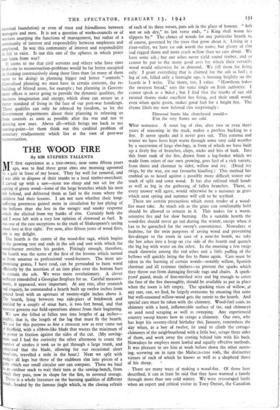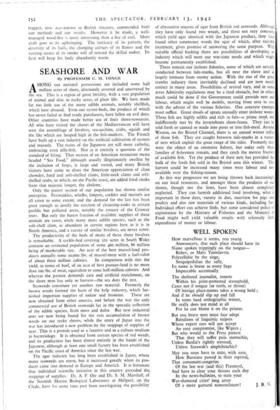THE WOOD FIRE
By SIR STEPHEN TALLENTS
MY first experience as a tree-owner, now some fifteen years ago, was to find three great elms one morning uprooted by a gale in front of my house. They lay well for removal, and I was able to dispose of their trunks to a local timber-merchant. 1 carved up with a saw—none too sharp and not set for the cutting of green wood—some of the large branches which his men left behind, and delivered them as fuel to the room where the children had their lessons. I am not sure whether their long- suffering governess gained more in circulation by her plying of the bellows than she lost in the meagre and smoky response which she elicited from my hunks of elm. Certainly both she and I were left with a very low opinion of elmwood as fuel. It was one of the rare exceptions to the truth of Shakespeare's saying about love at first sight. For now, after fifteen years of wood fires, elm is my delight.
The hearth is the centre of the wood-fire saga, which begins in the growing tree and ends in the ash and soot with which the wood-burner enriches his garden. Fittingly enough, therefore, the hearth was the scene of the first of the lessons which turned us from amateur to professional wood-burners. The most un- promising grates, I have read, can be persuaded to burn wood efficiently by the insertion of an iron plate over the bottom bars to contain the ash. We were more revolutionary. A clever architect remodelled a.Georgian fireplace for us. Careful measure- ments, it appeared, were important. At any rate, after research and enquiry, he commanded a hearth built up twelve inches from ground level with an aperture of twenty-eight inches above it. The hearth, lying between twp side-piers of brickwork and guarded by a couple of stout bars, is two feet broad, and that measure governs our field-operations almost from their beginning. We saw the felled or fallen tree into lengths of 44 inches— double, that is, the length of the log that must fit the hearth. We use for this purpose as fine a crosscut saw as ever came out of Sheffield, with a ribbon-like blade that wastes the minimum of Its power in friction against the sides of the cut. (My sawing- mate and I had the curiosity the other afternoon to count the umber of strokes it took us to get through a large trunk, and calculated that the blade, allowing for our occasional short breathers, travelled a mile in the hour.) Next we split with edges all logs but those of the stubborn elm into pieces of a trth which our small circular saw can compass. These we haul o an outdoor stack to wait their turn at the sawing-bench, from hich they pass, now in shape for the fire, to covered storage. There is a whole literature on the burning qualities of different clods, headed-by the famous jingle which, in the closing refrain
of each of its three verses, puts ash in the place of honour. " Ash wet or ash dry," its last verse ends, " a King shall warm his slippers by." The choice of woods for any particular hearth is, of course, governed by the trees that grow about it. Living in a river-valley, we have no oak worth the name, but plenty of elm and ragged thorn and more crack willow than we care about. We have some ash ; but our ashes never yield sound timber, and so cannot be put to the many good uses for which their versatile wood would otherwise be in demand. We fell them for firing only. I grant everything that is claimed for the ash as fuel ; a log of ash, felled only a fortnight ago, is burning brightly on the hearth as I write. The thorn, too, I value. " Hawthorn bakes the sweetest bread," says the same jingle on Irish authority. I cannot speak as a baker ; but I find that the trunks of our old twisted thorns make excellent hot firing, and their small wood, even when quite green, makes good fuel for a bright fire. The rhyme libels my now beloved elm surprisingly : Elmwood burns like churchyard mould— E'en the very flames are cold.
What nonsense. A stout log of elm, after two or even three years of seasoning in the stack, makes a peerless backing to a fire. It never sparks and it never goes out. This autumn and winter we have been kept warm through some very cold weather by a succession of large elm-logs, in front of which we have built up a lively fire of branches, chips, sticks and bits of bark. Into this front rank of the fire, drawn from a log-basket which we made from osiers of our own growing, goes fuel of a rich variety, from thorn and chestnut to alder, willow and ivy. (Dried ivy twigs, by the way, are our favourite kindling.) This method has enabled us to hoard against a possibly more difficult winter our stock of split and sawn wood. It has also enlisted small hands as well as big in the gathering of fallen branches. These, as every mower will agree, would otherwise be a- nuisance in grass which next spring and summer will call to be scythed.
There are certain precautions which every tender of a wood- fire must take. As much ash as the grate can comfortably hold should be allowed to remain in it. This makes for a warm, retentive fire and for slow burning On a suitable hearth the wood-fire should never go out during the winter, except when it has to be quenched for the sweep's convenience. Nowadays at bedtime, for the twin purposes of saving wood and preventing fire-danger to the room in case of a near-by bomb, we rake the hot ashes into a heap on one side of the hearth and quench the big log with water on the other. In the morning a few twigs stuck slantwise among the red ashes and a little puffing of the bellows will quickly bring the fire to flame again. Care must be taken in the burning of certain woods—notably willow, Spanish chestnut and all resinous timbers—to prevent the sparks which they throw out from damaging fireside rugs and chairs. A spark- proof guard, made of fine-meshed wire and big enough to cover the face of the fire thoroughly, should be available to put in place
when the room is left empty. The sparking vices of willow, at any rate, can, we find, be largely overcome by ensuring that none but well-seasoned willow-wood gets the entrée to the hearth. And special care must be taken with the chimney. Wood-fuel coats its chimney with a hard, inflammable surface of tar, and chimneys so used need scraping as well as sweeping. Any experienced country sweep knows how to ecrape a chimney. Our own, who has kept his seventy-third birthday this January, remembers the day when, as a boy of twelve, he used to climb the cottage- chimneys of the neighbourhood with a little hoe, scrape three sides of them, and work away the coating behind him with his back.
Nowadays he employs more lawful and equally effective methods. It was pleasant to see him at work before dawn the other morn- ing, screwing on in turn the Malacca-cane rods, the distinctive virtues of each of which he knows as well as a shepherd those of his sheep.
There are many ways of making a wood-fire. Of those here described, it can at least be said that they have warmed a family through more than one cold winter. We were encouraged lately when an expert and critical visitor in Tony Onraet, the Canadian
trapper, now well-Known to British listeners, commended both our methods and our results. However it be made, a well- managed wood-fire is more interesting than a fire of coal. More craft goes to its upbringing. The intricacy of its pattern, the diversity of its fuels, the changing colours of its flames and the varying scents of its smoke will all reward the skilful maker. Its heat will keep his body abundantly warm.



























 Previous page
Previous page